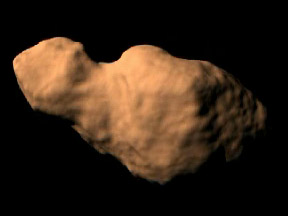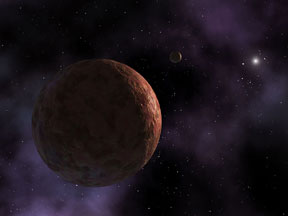This picture shows the orbit of Toutatis. It flew close to Earth in September 2004.
Click on image for full size
Windows to the Universe original artwork by Randy Russell, based on orbital information from NASA's Near Earth Object Program.
Asteroid Toutatis Passes Near Earth
News story originally written on October 1, 2004
A large asteroid passed near Earth on September 29,
2004. How close was it? Not close enough to worry about! Asteroid Toutatis passed
within about 1.5
million kilometers (961 thousand miles) of Earth, about four times the distance
to the Moon.
Toutatis is an odd asteroid. It is shaped sort of like a potato. It is about
4.6 km (2.9 miles) long. An asteroid that big would make a big mess if it actually
hit Earth. Astronomers don't think any asteroids that big will pass as close
to Earth this century.
Toutatis was discovered in 1989. It is named after a god of the Celts and
Gauls. Toutatis was a god of war and growth. His name means 'king of the world',
'king of battle' or 'father of the tribe'.
You might also be interested in:

Toutatis is a very strange asteroid. It has a strange shape, and it spins in a very unusual way. Sometimes Toutatis comes close to Earth. This asteroid is shaped sort of like a potato. Its size is 1.92
...more
Astronomers have discovered a new planetoid at the far edge of our Solar System. The new object, named Sedna, is probably almost as big as the smallest planet, Pluto. Sedna is very, very far away. It is
...more
A large asteroid passed near Earth on September 29, 2004. How close was it? Not close enough to worry about! Asteroid Toutatis passed within about 1.5 million kilometers (961 thousand miles) of Earth,
...more
Scientists have recently discovered that thousands of Adelie Penguins thrive in patches of the chilly Southern Ocean near Antarctica's coastline. In these special areas of the ocean, called polynyas,
...more
Scientists have learned that Mount Hood, Oregon's tallest mountain, has erupted in the past due to the mixing of two different types of magma. "The data will help give us a better road map to what a future
...more
The Earth's mantle is a rocky, solid shell that is between the Earth's crust and the outer core, and makes up about 84 percent of the Earth's volume. The mantle is made up of many distinct portions or
...more
Some geologic faults that appear strong and stable, slip and slide like weak faults, causing earthquakes. Scientists have been looking at one of these faults in a new way to figure out why. In theory,
...more














